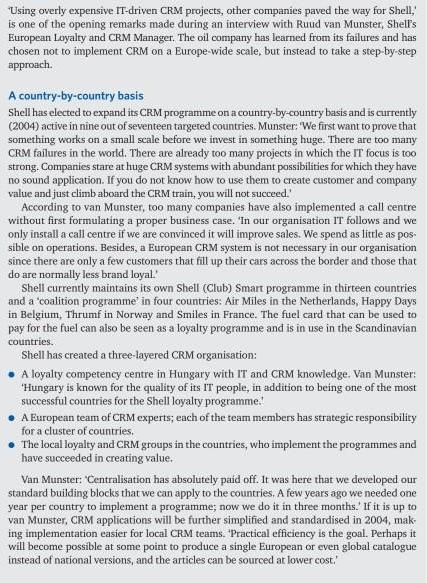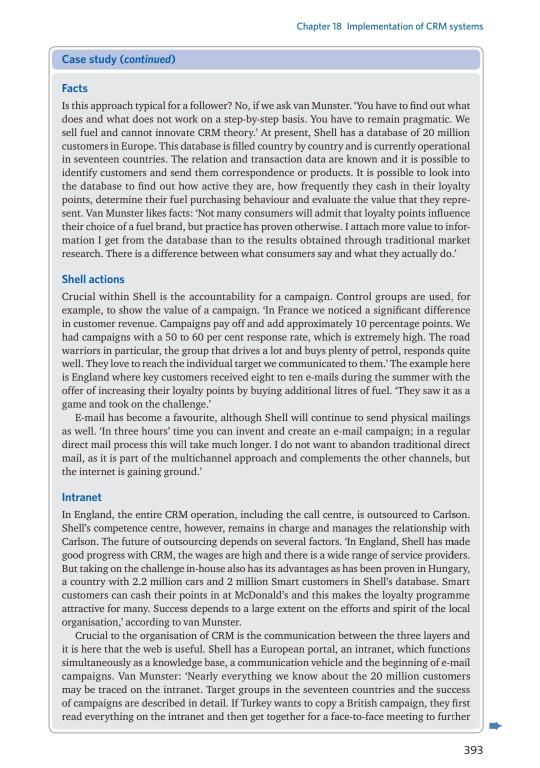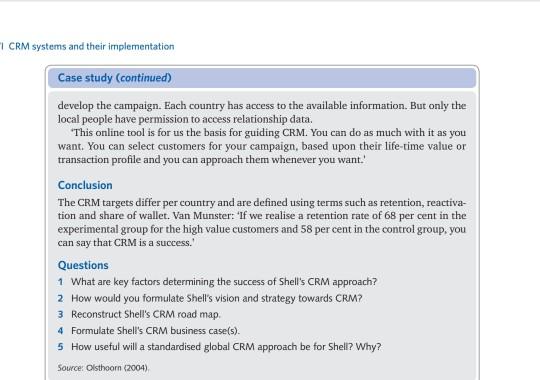Answered step by step
Verified Expert Solution
Question
1 Approved Answer
*Using overly expensive IT-driven CRM projects, other companies paved the way for Shell, is one of the opening remarks made during an interview with



*Using overly expensive IT-driven CRM projects, other companies paved the way for Shell, is one of the opening remarks made during an interview with Ruud van Munster, Shell s European Loyalty and CRM Manager. The oil company has learned from its failures and has chosen not to implement CRM on a Europe-wide scale, but instead to take a step-by-step approach. A country-by-country basis Shell has elected to expand its CRM programme on a country-by-country basis and is currently (2004) active in nine out of seventeen targeted countries. Munster: We first want to prove that something works on a small scale before we invest in something huge. There are too many CRM failures in the world. There are already too many projects in which the IT focus is too strong. Companies stare at huge CRM systems with abundant possibilities for which they have no sound application. If you do not know how to use them to create customer and company value and just climb aboard the CRM train, you will not succeed. According to van Munster, too many companies have also implemented a call centre without first formulating a proper business case. In our organisation IT follows and we only install a call centre if we are convinced it will improve sales. We spend as little as pos sible on operations. Besides, a European CRM system is not necessary in our organisation since there are only a few customers that fill up their cars across the border and those that do are normally less brand loyal. Shell currently maintains its own Shell (Club) Smart programme in thirteen countries and a coalition programme in four countries: Air Miles in the Netherlands, Happy Days in Belgium, Thrumf in Norway and Smiles in France. The fuel card that can be used to pay for the fuel can also be seen as a loyalty programme and is in use in the Scandinavian countries. Shell has created a three-layered CRM organisation: A loyalty competency centre in Hungary with IT and CRM knowledge. Van Munster: Hungary is known for the quality of its IT people, in addition to being one of the most successful countries for the Shell loyalty programme. A European team of CRM experts; each of the team members has strategic responsibility for a cluster of countries. The local loyalty and CRM groups in the countries, who implement the programmes and have succeeded in creating value. Van Munster: Centralisation has absolutely paid off. It was here that we developed our standard building blocks that we can apply to the countries. A few years ago we needed one year per country to implement a programme; now we do it in three months. If it is up to van Munster, CRM applications will be further simplified and standardised in 2004, mak- ing implementation easier for local CRM teams. Practical efficiency is the goal. Perhaps it will become possible at some point to produce a single European or even global catalogue instead of national versions, and the articles can be sourced at lower cost. Chapter 18 Implementation of CRM systems Case study (continued) Facts Is this approach typical for a follower? No, if we ask van Munster. You have to find out what does and what does not work on a step-by-step basis. You have to remain pragmatic. We sell fuel and cannot innovate CRM theory. At present, Shell has a database of 20 million customers in Europe. This database is filled country by country and is currently operational in seventeen countries. The relation and transaction data are known and it is possible to identify customers and send them correspondence or products. It is possible to look into the database to find out how active they are, how frequently they cash in their loyalty points, determine their fuel purchasing behaviour and evaluate the value that they repre- sent. Van Munster likes facts: Not many consumers will admit that loyalty points influence their choice of a fuel brand, but practice has proven otherwise. I attach more value to infor- mation I get from the database than to the results obtained through traditional market research. There is a difference between what consumers say and what they actually do. Shell actions Crucial within Shell is the accountability for a campaign. Control groups are used, for example, to show the value of a campaign. In France we noticed a significant difference in customer revenue. Campaigns pay off and add approximately 10 percentage points. We had campaigns with a 50 to 60 per cent response rate, which is extremely high. The road warriors in particular, the group that drives a lot and buys plenty of petrol, responds quite well. They love to reach the individual target we communicated to them. The example here is England where key customers received eight to ten e-mails during the summer with the offer of increasing their loyalty points by buying additional litres of fuel. They saw it as a game and took on the challenge. E-mail has become a favourite, although Shell will continue to send physical mailings as well. In three hours time you can invent and create an e-mail campaign; in a regular direct mail process this will take much longer. I do not want to abandon traditional direct mail, as it is part of the multichannel approach and complements the other channels, but the internet is gaining ground. Intranet In England, the entire CRM operation, including the call centre, is outsourced to Carlson. Shell s competence centre, however, remains in charge and manages the relationship with Carlson. The future of outsourcing depends on several factors. In England, Shell has made good progress with CRM, the wages are high and there is a wide range of service providers. But taking on the challenge in-house also has its advantages as has been proven in Hungary, a country with 2.2 million cars and 2 million Smart customers in Shell s database. Smart customers can cash their points in at McDonald s and this makes the loyalty programme attractive for many. Success depends to a large extent on the efforts and spirit of the local organisation, according to van Munster. Crucial to the organisation of CRM is the communication between the three layers and it is here that the web is useful. Shell has a European portal, an intranet, which functions simultaneously as a knowledge base, a communication vehicle and the beginning of e-mail campaigns. Van Munster: Nearly everything we know about the 20 million customers may be traced on the intranet. Target groups in the seventeen countries and the success of campaigns are described in detail. If Turkey wants to copy a British campaign, they first read everything on the intranet and then get together for a face-to-face meeting to further 393 CRM systems and their implementation Case study (continued) develop the campaign. Each country has access to the available information. But only the local people have permission to access relationship data. This online tool is for us the basis for guiding CRM. You can do as much with it as you want. You can select customers for your campaign, based upon their life-time value or transaction profile and you can approach them whenever you want. Conclusion The CRM targets differ per country and are defined using terms such as retention, reactiva- tion and share of wallet. Van Munster: If we realise a retention rate of 68 per cent in the experimental group for the high value customers and 58 per cent in the control group, you can say that CRM is a success. Questions 1 What are key factors determining the success of Shell s CRM approach? 2 How would you formulate Shell s vision and strategy towards CRM? 3 Reconstruct Shell s CRM road map. 4 Formulate Shell s CRM business case(s). 5 How useful will a standardised global CRM approach be for Shell? Why? Source: Olsthoorn (2004)
Step by Step Solution
★★★★★
3.41 Rating (182 Votes )
There are 3 Steps involved in it
Step: 1
Answers to the case 1 The key factors determining the success of Shells CRM approach are the following Implementation in small scale to use the applicability of the CRM rather than spending huge amoun...
Get Instant Access to Expert-Tailored Solutions
See step-by-step solutions with expert insights and AI powered tools for academic success
Step: 2

Step: 3

Ace Your Homework with AI
Get the answers you need in no time with our AI-driven, step-by-step assistance
Get Started


